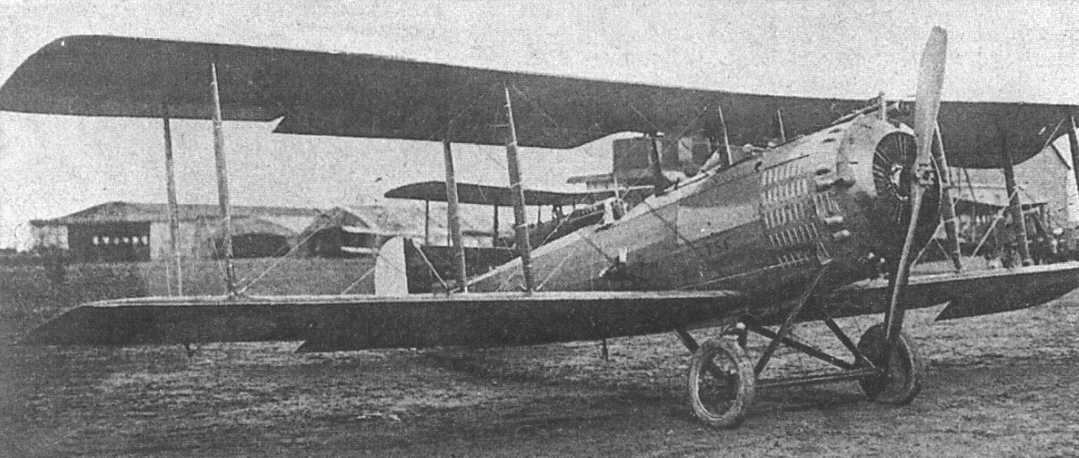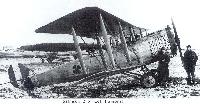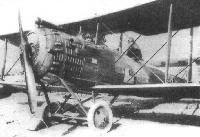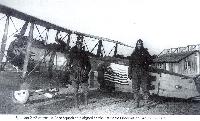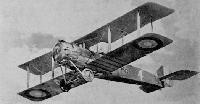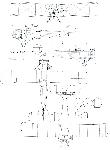В.Кондратьев Самолеты первой мировой войны
САЛЬМСОН SAL.2 / SALMSON SAL.2
Цельнодеревянный двухстоечный биплан с полотняной обшивкой по всем поверхностям за исключением дюралевого капота мотора. Характерные особенности машины - отсутствие киля и стабилизатора (как на ранних "Моранах", хвостовое оперение составляли только цельноповоротные рули) и оригинальный звездообразный двигатель водяного охлаждения с лобовым радиатором. Самолет разработан в начале 1917 года конструкторским коллективом фирмы Сосьете дес Моторс Сальмсон. В апреле "Сальмсон 2" успешно прошел испытания и был рекомендован к принятию на вооружение французских ВВС.
Серийное производство началось в конце 1917-го, а в январе следующего года "Сальмсон 2" начал поступать на западный фронт. Он широко применялся до конца войны в качестве разведчика и ближнего бомбардировщика, заслужив репутацию хотя и не лучшей в своем классе, но вполне добротной и надежной машины. Единственный отмеченный недостаток был тот же, что и у английского DH.4 - большое расстояние между кабинами пилота и летнаба. При отсутствии бортовых переговорных устройств это не позволяло членам экипажа поддерживать между собою связь в полете.
Всего построено 3200 экземпляров "Сальмсона". На них воевали 19 французских эскадрилий на западном фронте и еще две - в Италии. Кроме того, с апреля по ноябрь 1918 года 750 машин передали американскому экспедиционному корпусу. Их намеревались использовать до тех пор, пока авиапромышленность США не наладит массовый выпуск более современных "Де Хэвиллендов" DH.9a. Но война закончилась раньше.
ДВИГАТЕЛЬ
"Сальмсон Z9", 260 л.с.
ВООРУЖЕНИЕ
1 синхр. "Виккерс" и 1 или 2 турельных "Льюиса", до 24 противопехотных бомб
Показать полностью
А.Шепс Самолеты Первой мировой войны. Страны Антанты
Сальмсон Sаl.2 B2 1917 г.
Моторостроительная фирма "Сальмсон" в ходе войны выпускала звездообразные двигатели жидкостного охлаждения гораздо более мощные, чем ротативные "Гном" и "Рон". В ходе войны мощность двигателей фирмы постоянно повышалась. К концу 1917 года мощность двигателя была доведена до 265 л. с. В это время был объявлен конкурс на разведчик и легкий бомбардировщик для французских ВВС. Э. Сальмсон также подготовил к конкурсу новый самолет.
Это был второй самолет фирмы. Это был двухстоечный биплан - двухместный, одномоторный самолет смешанной конструкции. Стрингеры фюзеляжа и лонжероны крыла изготавливались из стальных труб. Шпангоуты и нервюры оставались деревянными. Оставалась и обтяжка полотном. Капот двигателя фактически копировал капот самолета HD.3 C2, для которого фирма поставляла свои двигатели. Кабина пилота размещалась сразу за двигателем. Кабина стрелка-бомбардира размещалась за задней кромкой крыла и оборудовалась турелью. Между кабинами размещался топливный бак, а топливо подавалось насосом, работающим от вертушки. Расходный топливный бак, обеспечивающий запуск двигателя, размещался в заголовнике пилота. Крылья оборудовались элеронами. Оперение не имело ни киля, ни стабилизатора. Поворот осуществлялся вокруг своей оси, крепившейся системой стоек и раскосов. Шасси обычное, со стойками из стальных профилированных труб, сплошной осью и шнуровой резиновой амортизацией. Вооружение состояло из синхронного пулемета "Виккерс" 7,71-мм перед кабиной пилота и двух 7,69-мм пулеметов "Льюис" на турели у стрелка. Под крылом подвешивались бомбы общей массой 160 кг. Машина выпускалась и в варианте разведчика (отсутствовали бомбодержатели) и обозначались Sаl.2 A2. Несколько машин передали американскому экспедиционному корпусу.
ЛЕТНО-ТЕХНИЧЕСКИЕ ХАРАКТЕРИСТИКИ
Sal.2 В2 1917г.
Размах, м 11,80
Длина, м 8,50
Высота, м 2,90
Площадь крыла.кв.м 38,0
Сухой вес, кг 780
Взлетный вес, кг 1340
Двигатель: "Сальмсон"
мощность, л. с. 265
Скорость максимальная, км/ч 185
Время набора высоты, м/мин 3000/11,6
Дальность полета, км 520
Потолок, м 6250
Экипаж, чел. 2
Вооружение 2-3 пулемета
160 кг бомб
Показать полностью
J.Davilla, A.Soltan French Aircraft of the First World War (Flying Machines)
Salmson 2 A2
It soon became clear to the Aviation Militaire that the reconnaissance units' A.R.1s and A.R.2s were underpowered and that the Sopwith 1 1/2 Strutters were too fragile and carried an inadequate payload. A requirement for a two-seat reconnaissance aircraft capable of carrying a crew of two, several machine guns, a camera, and a T.S.F. unit was announced in 1916. Several aircraft were developed to meet this requirement; including the Breguet 14 and the Salmson 2 A2.
The Societe des Moteurs Salmson, which had previously concentrated on the production of aero engines, had gained considerable experience in aircraft manufacturing when it had built Sopwith 1 1/2 Strutters under license. To meet the new requirement it designed a completely new biplane, drawing upon the knowledge acquired in producing the Sopwith machines.
The Salmson 2 was a biplane powered by a 230-hp Salmson 9Za. The wings were of equal span with ailerons on both the upper and lower wings. The wings had two hollow spars of spruce. The ribs were plywood and the bottom was covered with poplar. The spars of the lower wing were attached to the fuselage longerons by metal fittings. The upper wing was held in place on the fuselage by the cabane struts and was attached to the lower wing by two bays of struts.
The fuselage had a rectangular structure composed of four longerons with several fuselage formers which were attached by hinges and reinforced by a latticework of piano wire. At the rear were vertical tubes to which the rudder and vertical stabilizer were attached. The longerons were made of ash sheathed in aluminum at their attachment points. There were two 100-liter fuel tanks, both held in cradles in the lower fuselage. The oil tank held 47 liters and was located on the right side of the fuselage beneath a rounded fairing. The engine was mounted on two metal holders which were held together by a U-shaped support. The motor mount was attached to the fuselage longerons by bolts. The armament was two flexible 7.7-mm Lewis guns and a synchronized 7.7-mm Vickers.
The undercarriage had six struts (three per side) attached to the motor mount and the rear spar. The articulated axle was wrapped in bungee chord to act as a shock absorber. The tail skid was a tube of duralumin attached to the lower fuselage.
A Salmson 2 underwent STAe testing on 29 April 1917. With a military load of 510 kg the following results were obtained:
Maximum Speed Time to Climb
- 1,000 m in 3 minutes 10 seconds
187 km/h at 2,000 2,000 m in 6 minutes 45 seconds
185 km/h at 3,000 3,000 m in 11 minutes 15 seconds
177.5 km/h at 4,000 4,000 m in 17 minutes 40 seconds
168 km/h at 5,000 5,000 m in 27 minutes 30 seconds
The performance was good and the test pilot stated that the Salmson 2 responded well to the controls but the nose tended to wander ("hunt") when coming out of a turn. It was recommended that the bungee chords attached to the rudder be tightened. A drawback in combat was the considerable distance between the pilot and gunner.
It had not been planned to equip the aircraft with bomb racks; however, as the war progressed modifications were carried out to some Salmson 2s to enable them to carry 230 kg of bombs for ground attack.
Production totaled 3,200 aircraft. Salmson produced 2,200 and the remaining 1,000 were built by Latecoere, Hanriot, and Desfontaines.
Variants
The aircraft underwent remarkably few changes during its service career. Latecoere, which built the type under license, produced a number of interesting variants. The Latecoere Type 2 was a Salmson 2 modified to conform more closely to the Latecoere production process. Only six were built; the other aircraft produced at that plant were assembled without modification. The Latecoere firm also modified one aircraft to enable it to carry a torpedo; however, no production of this type was undertaken.
The Salmson 2 D2 was a two-seat training version of the Salmson 2. The D designation stood for double command (dual control). In addition to having dual controls fitted, the Salmson 2 D2s were fitted with 130-hp Clerget 9B engines. Several were built in 1917.
Operational Service
It appears that the first escadrille to be equipped with Salmson 2s was SAL 122, formed from C 122 (equipped with Caudron G.6s) in October 1917. The A.R.1 and A.R.2 had proved to be mediocre aircraft and many of the escadrilles that used them were re-equipped with Salmson 2s. The Sopwith 1 1/2 Strutter had performed well but was clearly outdated by late 1917; the Salmson 2 was far superior, especially in terms of its ability to carry a much heavier payload over greater distances. The Salmson 2-equipped escadrilles used their new aircraft for short-range reconnaissance, artillery spotting, ground attack, and even leaflet-dropping missions.
Postwar Service
Postwar, the number of Salmson 2 escadrilles declined rapidly, but a substantial number of these units were included in the 1920 reorganization of the Armee d l'Air. These included:
1st RAO: SAL 10, 203, 277.
3rd RAO: SAL 19, 27, 33, and 56.
4th RAO: SAL 1, 14, 18, and 259.
5th RAO: SAL 17 and 32.
6th RAO: SAL 39 and 59.
7th RAO: SAL 8 and 105.
RA in Algeria and Tunis: SAL 71.
31st RAO: SAL 10 and 277.
33rd RAO: SAL 6, 17, 19, and 33.
34th RAO: SAL 1,18, 34, and 254.
35th RAO: SAL 32 and 52.
37th RA (North Africa): SAL 8 and 105.
36th Groupe Autonome d'Observation in Algeria/Tunisia: SAL 58 and 253.
1st Groupe at Rayak: SAL 16.
2nd Groupe at Mouslimie: SAL 24.
3rd Groupe at Rakka: SAL 40 and 203.
By September 1923 the Salmson 2s had been completely replaced by Potez 15s and Breguet 19s.
Postwar, the Aviation Maritime purchased a few surplus Salmson 2s to equip the reconnaissance unit assigned to the Aviation d'Escadre (Fleet Aviation). Unlike the pilots of the Aviation Militaire, the naval pilots found the Salmsons difficult to fly. Because of their poor maneuverability, Salmson 2s were not operated from the aircraft carrier Bearn. Instead, they were relegated to training duties and were based at the CAM St.Raphael. They were replaced by Breguet 14s in 1921.
Approximately 36 Salmson 2s found their way on to the civil register after the war. Modified versions saw limited service as airliners. Latecoere built 20 Salmson 2s incorporating a two-seat passenger cabin. They were used by the Lignes Aeriennes Latecoere. However, the cabins, which were located in the position previously occupied by the observer, were never satisfactory. Oil frequently entered the cabin through the ventilation ports. In addition, there were numerous failures of the propeller bolts, and the carburetors were unreliable. The latter problem was so severe that Latecoere modified an airframe to accept a new, more reliable carburetor. A slight modification to the old carburetors obviated the need for this modification. Salmson 2 airliners were used by Lignes Aeriennes Latecoere (approximately 40 aircraft), Cie Franco-Roumaine (14 ), CIDNA (5), CMA (2), Cie Gle Transaerienne, Cie Air Transport (1), Air Union (1), and Aero-Transports Ernoul (14).
Foreign Service
Belgium
The Belgian air service obtained a single "war orphaned" Salmson 2 confiscated by the commander of the 4th Escadrille based at Hondschote.
Czechoslovakia
The Czechoslovakian air service purchased 50 Salmson 2s in 1919. They equipped 3 Letecka Setnina (Olomouc), 6 Letecka Setnina (Vajnory), Letecke Dilny (Olomouc), and Letecke Sklady (Praha). In 1923 they were assigned to 1 Pozorovaci Rota (Olomouc), 2 Pozorovaci Rota (Praha-Kbely), 6 Pozorovaci Rota (Vajnory), 7 Pozorovaci Rota (Kosice), 8 Pozorovaci Rota (Nitra), Letecka Pluk, Dilna (Nitra); Letecka Pluk Sklad (Nitra), and Hlavni Vzduchoplavecky Sklad (Olomouc). They were withdrawn from service by 1924.
Japan
The Japanese used the Salmson 2 in large numbers. After examining one taken to Japan in 1919 by the Mission Francaise d'Aeronautique, arrangements were made to produce the aircraft under license. They were initially built by the Tokorozawa Army Air Base Arsenal in Nagoya beginning in 1920; later the Kawasaki Aircraft Company built about 300. The aircraft equipped one Japanese army air service reconnaissance battalion and served as part of the reconnaissance component of the four mixed battalions. Known units include the 2nd Air Regiment (Kagamigahara), 4th Air Regiment (Tachiarai), 5th Air Regiment (Tachikawa), 6th Air Regiment (Chijo, Korea), and the 8th Air Regiment (Heito, Formosa). Some of the Salmson 2s were assigned to bomber units and saw action in the Siberian, Manchurian, and Shanghai incidents. They were replaced in 1933 by the Type 88 reconnaissance aircraft. Between 600 and 1,000 Salmson 2s were built in Japan. One (J-BAEF) was supplied directly to Japan Air Lines and the Asahi Press Group by the Japanese army. Eventually, a total of 12 Salmson 2s were used by Japan Air Lines.
Peru
Peru acquired four Salmson 2s when a French air mission arrived in November 1919. They were used as advanced trainers.
Poland
Poland acquired its Salmson 2s directly from France when the French government turned over the equipment of three Salmson units to the Polish government. Beginning in June 1919 SAL 580, 581, and 582 gave their Salmson 2s to the fledgling Polish air service. SAL 580 arrived first, in June 1919, flying directly from France to Priotrkow. In March 1920 its aircraft formed the 18th Polish Squadron. However, they were probably in poor shape as the unit had to disband in July of that year because of a lack of usable planes. SAL 581's aircraft equipped the Polish observer's school. SAL 582 arrived in Warsaw in December 1918 and by September 1919 its aircraft were being used by the Polish 1st Squadron. By August 1920 that unit had re-equipped with Bristol F 2Bs.
Russia/Soviet Union
In 1919 one Salmson 2 was captured in the south and a second is known to have been captured in Caucasia in 1922. By 1923 nine Salmson 2s were on the strength of the RKKVF (Worker's and Peasant's Red Air Fleet). They served with the 17th And 18th Otdel'nye Razvedivatel'nye Aviaotryady at Chita and the 5th Postoyannaya Aviabaza in Siberia. The last aircraft was probably stuck off charge in 1926. The Siberian Air Fleet of Admiral Kolchak had 23 Salmson 2s on strength in 1920. The Siberian Air Fleet of the Far Eastern Republic had four Salmson 2s in 1920; they had serial numbers 1, 2, 3, and 4.
Spain
Spain acquired a single Salmson 2 in February 1920 for evaluation by the Servicio d'Aeronautica Militar. No others were purchased by the Spanish.
United States
The A.E.F. air service purchased 705 Salmson 2s. The first 18 arrived in April 1918 and were used to replace A.R.1s and Sopwith 1 1/2 Strutters. These units of the 1st Army used Salmson 2s:
1st Corps Observation Group ( 1st, and 12th Corps Observation Squadrons)
3rd Corps Observation Group ( 88th and 90th Corps Observation Squadrons).
5th Corps Observation Group ( 99th and 104th Corps Observation Squadrons).
7th Corps Observation Group (258th Corps Observation Squadron).
1st Army Observation Group (24th and 91st Army Observation squadrons).
The 2nd Army had one unit, the 168th Corps Observation Squadron, that used Salmson 2s.
The American Salmson units saw action in the Aisne-Marne, St. Mihiel, and Meuse-Argonne offensives. The Salmson 2s were popular with the aircrew and were vastly superior to the A.R.1s, Sopwith 1 1/2 Strutters, and SPAD 16s. The first Salmsons supplied to the 1st and 12th Aero Squadrons had a Lewis gun mounted on the upper wing. However, this position degraded the aircraft's performance so severely that the guns were removed. Some Salmons were re-equipped with modified Lewis guns produced by the Savage Arms Co. The Vickers machine gun (synchronized to fire through the propeller) was replaced in some airplanes by Marlin machine guns. The Salmon 2 was found to be faster than Pfalz and Albatros fighters and also had a superior climb rate. However, its performance was inferior to that of the Fokker D.VII. One complaint noted by the aircrew was that there was room for only 48 photographic plates. This meant that only a relatively limited area could be photographed; to cover a larger area several Salmson 2s would have to be sent. However, overall, the Salmson 2s performed well in U.S. service.
Salmson 2 A2 Two-Seat Reconnaissance Aircraft with 230-hp Salmson 9Za
Span 11.750 m; length 8.500 m; height 2.90 m; wing area 37.270 sq. m
Empty weight 780 kg; loaded weight 1,290 kg
Maximum speed:
sea level 188 km/h
2,000 m 186 km/h
3,000 m 181 km/h
4,000 m 173 km/h
5,000 m 168 km/h
Climb:
1,000 m 3 minutes 18 seconds
2,000 m 7 minutes 13 seconds
4,000 m 17 minutes 20 seconds
5,000 m 27 minutes 30 seconds
Ceiling 6,250 m; range 500 km
Armament: one synchronized Vickers 7.7-mm machine gun and two ring-mounted 7.7-mm Lewis machine guns
A total of 3,200 were built
Army Type Otsu 1 (Kawasaki-Salmson 2) with 230-hp Salmson 9Za
Span 11.767 m; length 8.624 m; height 2.90 m; wing area 37.27 sq. m
Empty weight 903 kg; loaded weight 1,500 kg
Maximum speed: 101 kts at 2,000 m; climb to 3,000 m in 11 minutes 42 seconds; ceiling 5,800 m; endurance up to 7 hours
Armament: one synchronized 7.7-mm machine gun and one or two 7.7-mm machine guns on a ring mount
300 built by Kawasaki and approximately 300 built by Tokorozawa Branch of Army Supply Depot.
Salmson 2 D2 Dual-Control Trainer with 130-hp Clerget 9B
Span 11.75 m; length 8.76 m; height 2.86 m; wing area 37.27 sq. m
Maximum speed: 145 km/h�
Salmson 6
The Salmson 6 was designed to the 1918 STAe A2 specification calling for a single-engine army cooperation aircraft. It was based on the standard Salmson 2 and powered by a 230-hp Salmson 92a engine. Only a single example was built.
Показать полностью
G.Swanborough, P.Bowers United States Military Aircraft Since 1909 (Putnam)
SALMSON 2A-2
The Salmson 2A-2 was a standard French “heavy” observation design pressed into service with the A.E.F. along with the equivalent Breguet 14 when it became apparent that the American-built “Liberty Planes” would not be available for service when scheduled. Unconventional features of the Salmson were the installation of the 230-270-h.p. Salmson (formerly Canton-Unne) 9-cylinder water-cooled radial engine and the absence of a fixed fin and tailplane. Armament was a single 0-303-in. Vickers and twin Lewis guns. The A.E.F. acquired 705 Salmsons.
Показать полностью
R.Mikesh, A.Shorzoe Japanese Aircraft, 1910-1941 (Putnam)
Army Type Otsu 1 Reconnaissance Aircraft (Kawasaki-Salmson 2-A.2)
At the end of the First World War, the president of Kawasaki Dockyard, Kojiro Matsugata, received a strong indication that the Army intended acquiring a number of Salmson 2-A.2 aircraft. The Army was impressed by this aeroplane of which several were taken to Japan by the Mission Francaise d' Aeronautique in January 1919 and in which Japanese pilots and crews were trained by the French. Wishing to enter the aircraft manufacturing market, Matsugata went to Paris and acquired the manufacturing rights for the Salmson 2-A.2 reconnaissance aeroplane along with its engine. He also shipped two of these aircraft and one Salmson 7A.2 to Japan, arriving there in August 1919.
Before their arrival, Kawasaki secured a contract from the Army for the manufacture of the Salmson. In 1920, in order to study the Salmson manufacturing process, the company sent to the Salmson factory in France, Engineer Suzuki, and senior mechanics of the automobile section, Kasahara and Nishida along with Engineer Miwa and chief mechanic Hayashi of the head office, and they returned with the knowledge and materials needed for Salmson production. At the same time, the Army wanted to begin its own manufacture of this aircraft but only had a licence to build the engine. Army aircraft production began however, under the guise of 'aircraft repair.' Salmson filed a protest, and mediation by the manager of Kawasaki's Aeroplane Deparnnent, Tomokichi Takezaki, cleared the way for continued Army production.
The two production sources worked in collaboration. The Army completed its first Salmson 2-A.2 in late 1920 at Tokorozawa and officially accepted it in December 1921 as the Type Otsu 1 Reconnaissance Aircraft. Kawasaki sent engineers Suzuki and Arai to Tokorozawa to learn ways of speeding its own production and this enabled Kawasaki to complete its first two prototypes in November 1922. One, assembled from Army parts, the other built solely by Kawasaki, received serial numbers 1001 and 1002 respectively.When flight tests were successfully accomplished, the Army placed an order for 45 with Kawasaki, followed by further orders reaching 300 aircraft before production terminated in August 1927. These Japanese aircraft were identical to the French Salmson 2A.2 with the exception of some with modifications around the engine cowling and seats. Kawasaki imported fifty-six engines from Salmson for installation in early production aircraft, but after 1923 all airframes were equipped with Kawasaki-built engines. In time, the Army fitted some with dual controls to use them as trainers. Some variants had a forward-firing fixed machine-gun, or wing-mounted shackles for six small bombs or small flare bombs.
In April 1923, when production of the Type Otsu 1 was well underway, Kawasaki began a performance-improvement project calling for modification of existing aircraft. Withdrawing two Type Otsu 1 aircraft from production and the imported Salmson 7-A.2, which was the French improved version of their 2-A.2, modifications were made on them, including the use of the more powerful 300hp Salmson AZ-9 engine, and a radiator change to the Lamblin type. Dimensions remained the same but the modified aircraft were 100kg heavier in empty weight. However, with the added power, an increase in performance was expected, but engine overheating problems brought a decision to retain the original 230hp Z-9 engines.
As the Army reorganized its air units according to the French system, the Type Otsu 1s were assigned to bomber units as interim light bombers. The first combat from the Army Type Otsu 1 took place in October 1922 while operating in Siberia. In the Manchurian and Shanghai Incidents, the Type Otsu 1s were also very active, not only in their original reconnaissance role, but for bombing, liaison, light cargo transport, message pick-up and dropping, smoke-screen laying and ration re-supply. Because of their large numbers they remained in service as the Army's primary aircraft until replaced by the Type 88 Reconnaissance Aircraft around 1933. Those released to civilians as surplus aircraft were popular during the biplane era together with Avro 504Ks and Hanriots.
Single-engine two-bay reconnaIssance biplane. All-wood structure with fabric covering. Crew of two in open cockpits.
230-260hp Kawasaki Salmson Z.9 nine-cylinder water-cooled radial engine, driving a two-bladed wooden propeller.
Single or twin dorsal flexible 7. 7mm machine-guns, with optional forward-firing fixed 7.7mm machine-gun.
Span 11.767m (38ft 71/4in); length 8.624m (28ft 3in); height 2.90m (9ft 6in); wing area 37.27sq m (401.174sq ft).
Empty weight 930kg (2,050Ib); loaded weight 1,500kg (3,306Ib); wing loading 40.2kg/sq m (8.2Ib/sq ft); power loading 6.51 kg/hp (14.35Ib/hp).
Maximum speed 101 kt (116mph) at 2,000m (6,562ft); climb to 3,000m (9,843ft) in 11 min 42 sec; service ceiling 5,800m (19,028ft); endurance 3 1/2-7hr
300 built by Kawasaki from November 1922 to August 1927 and approximately 300 built by Tokorozawa Branch of Army Supply Dept.
Показать полностью
J.Stroud European Transport Aircraft since 1910 (Putnam)
Salmson 2-A.2
The Salmson 2-A.2 two-seat reconnaissance biplane was built by Société des Moteurs Salmson, and the prototype completed its trials in April 1917 at Villacoublay. It entered service with the French Air Force early in 1918, and was adopted by the United States as the standard reconnaissance type. A total of 3,200 was built.
The 2-A.2 was an equal span two-bay biplane of mixed construction. The fuselage was circular in section for much of its length, and the 230 hp Salmson Z.9 or 260 hp Salmson CM.9 water-cooled radial engine was neatly cowled. The pilot’s cockpit was under the leading edge, and the second cockpit was very far aft. The aircraft had no fin.
A considerable number of Salmson 2-A.2s were used by civil operators, and some of them were rebuilt with a two-passenger cabin aft of the pilot’s cockpit. Some Salmsons were built, or rebuilt, by Latécoére and that company’s airline, Lignes Aériennes Latécoére, operated a large number. It had 17 in its fleet in May 1922, and the total number used by the airline was probably about 40. It was an open cockpit Salmson with military markings that was used on Latécoére’s first experimental mail flight from Toulouse to Rabat and Casablanca in July 1919.
Cie Franco-Roumaine had at least 14 Salmsons, and five of them passed to CIDNA in 1925; they were based at Le Bourget, Strasbourg and Prague. CMA had two Salmsons; Cie Gle Transaérienne is reported to have used Salmsons on its Paris-London services in 1919 and 1920; Cie Air Transport had at least one which passed to Air Union; Aero-Transports Ernoul had 14 Salmsons in 1922; and Japan Airways had at least 12, which were built by Kawasaki and the Nagoya Arsenal.
F-ALVI, of the Latécoére fleet, is known to have been a Limousine version, and F-ALAO, another Limousine, may also have belonged to the airline; CIDNA had Limousines, and it is likely that many of the airline Salmsons were of the enclosed type, but confirmation has not proved possible.
Span 11-75 m (38 ft 6 in); length 8-5 m (27 ft 10 1/2 in); wing area 37 sq m (398-26 sq ft). Empty weight 906 kg (1,997 Ib); fuel 273 kg (601 Ib); useful load 200 kg (440 Ib); loaded weight 1,488 kg (3,280 Ib). Cruising speed at 2,000 m (6,561 ft) 140 km/h (86:9 mph); ceiling 4,500 m (14,763 ft); range 500 km (310 miles).
Figures are for the Limousine.
Показать полностью
